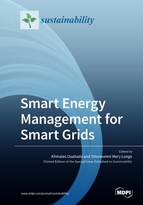Smart Energy Management for Smart Grids
A special issue of Sustainability (ISSN 2071-1050). This special issue belongs to the section "Energy Sustainability".
Deadline for manuscript submissions: closed (31 March 2019) | Viewed by 78051
Special Issue Editors
Interests: information theory; coding techniques; powerline communications; visible light communications; smart grid; energy demand management; renewable energy; wireless sensor networks; reverse engineering and engineering education.
Special Issues, Collections and Topics in MDPI journals
Interests: smart grid; distributed energy generation and storage; demand side management; renewable energy; electromobility
Special Issues, Collections and Topics in MDPI journals
Special Issue Information
Dear Colleagues,
The main goal of developing a smart energy management system is to help corporations, organizations, groups, and individuals use energy consumption data wisely in order to maintain and improve energy consumption. This is regarded as essential in the improvement of energy supplies, as it enhances access to more renewable energy usage at the household and community levels, which will also help with energy savings and CO2 emission reduction.
Energy management can be defined as the conservation, control, and monitoring of energy in a smart grid. The main focus in this Special Issue is the investigation of the best energy management systems within micro-grids, households, and communities in order to share energy in a very efficient way. Three different energy sources shall be discussed in this Special Issue. First, the energy generated and distributed by the utility, representing the main source of electricity to consumers. Second, energy storage devices, which include battery storage, electric vehicles, and large-scale energy storage, where customers or third-party energy producers can store energy from the utility grid during lower price periods, and use it during higher price periods. Thirdly, renewable energy that is generated from natural sources, which are continuously replenished sources, thereby creating relative or total energy independence from the grid for customers.
Smart energy management can be carried out at two levels, households and community or households groupings. At the households or smart homes level, an energy management system should be installed according to consumer type and demand. Each consumer should be able to optimise its energy consumption and trading for comfort and profit. The energy management system can also offer participating smart active consumers incentives above passive smart consumers. Also consumers should manage their internal energies from utility, storage and renewables. A smart energy management system should take control of these energy sources in order to maintain better consumption. At the community level, sharing the available energy between household will help creating a kind of independence that will help sustain the grid.
This Special Issue on “Smart Energy Management for Smart Grids”, opens the door for research on the importance of developing smart energy management systems by designing smart techniques, mathematical approaches, and algorithms in order to take control of energy consumption in smart homes and community households. The wise sharing of energy in a community can be modelled in a mathematical way, as in the case of many applications using game theory to create a demand-offer equilibrium that help manage and balance energy consumption. Contributors can submit both comprehensive surveys and original technical contributions on energy management within smart homes and micro-grids.
Prof. Dr. Eng. Khmaies Ouahada
Dr. Eng. Omowunmi Mary Longe
Guest Editors
Manuscript Submission Information
Manuscripts should be submitted online at www.mdpi.com by registering and logging in to this website. Once you are registered, click here to go to the submission form. Manuscripts can be submitted until the deadline. All submissions that pass pre-check are peer-reviewed. Accepted papers will be published continuously in the journal (as soon as accepted) and will be listed together on the special issue website. Research articles, review articles as well as short communications are invited. For planned papers, a title and short abstract (about 100 words) can be sent to the Editorial Office for announcement on this website.
Submitted manuscripts should not have been published previously, nor be under consideration for publication elsewhere (except conference proceedings papers). All manuscripts are thoroughly refereed through a single-blind peer-review process. A guide for authors and other relevant information for submission of manuscripts is available on the Instructions for Authors page. Sustainability is an international peer-reviewed open access semimonthly journal published by MDPI.
Please visit the Instructions for Authors page before submitting a manuscript. The Article Processing Charge (APC) for publication in this open access journal is 2400 CHF (Swiss Francs). Submitted papers should be well formatted and use good English. Authors may use MDPI's English editing service prior to publication or during author revisions.
Keywords
- Smart grid
- Micro-grid
- Smart homes
- Demand side management
- Energy storage
- Renewable energy







